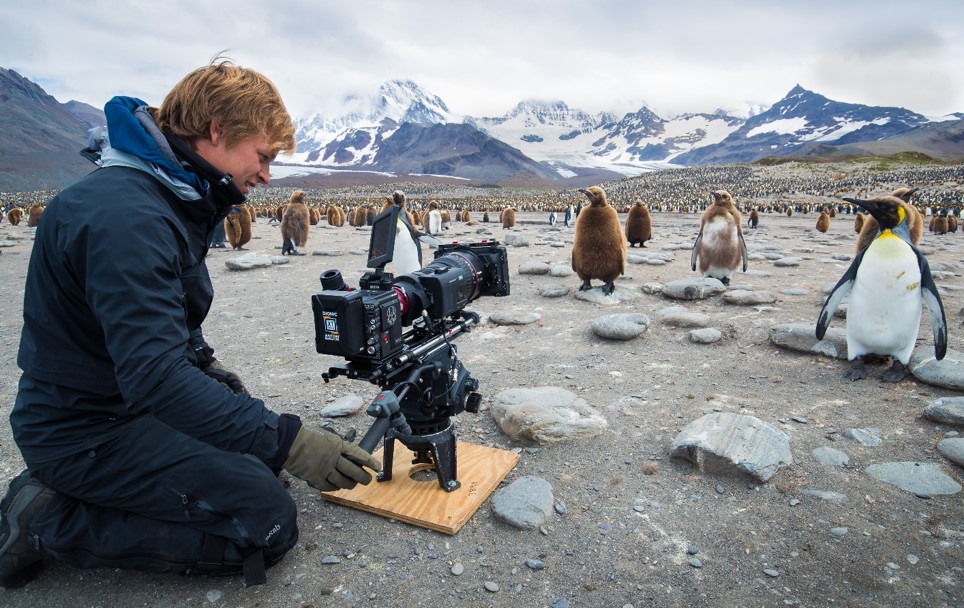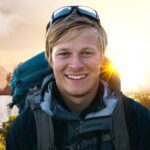Hunkered down with 400,000 penguins on a cold and rugged outcrop miles from civilisation would be an unusual day for most people – but not so for Bertie Gregory. At the age of just 22, he made history with the debut of “Wild_Life with Bertie Gregory,” National Geographic’s first-ever all-digital wildlife series and the cornerstone of its YouTube channel.
After a successful first season, in which Bertie focused on the coastal fauna of Canada’s Vancouver Island, Season Two of “Wild_Life” premiered last October with five online, 10-minute episodes and a one-hour TV special on the Nat Geo Wild channel. Entitled “Wild_Life: Resurrection Island,” the latest season places Bertie on the island of South Georgia, a tiny speck in the South Atlantic ocean nearly 1,000 miles from the nearest mainland. The full five-episode series, together with a selection of bonus content, is currently available through National Geographic’s online channels including natgeo.com, YouTube, Facebook, Instagram, and Snapchat.
“South Georgia is the holy grail of wildlife filmmaking, and it’s teeming with one of the highest concentrations of wildlife on the planet. It’s living proof that it’s not too late to save wild places.”
After a rough-and-tumble, 870-mile sea voyage aboard a 50-foot sailboat from the Falkland Islands, Bertie and his three-person Nat Geo film crew fetched up on South Georgia.
For several weeks, the crew would live at anchor and spend every day on the island, getting up close and personal with macaroni penguins, wandering albatrosses, fur seals, and other remarkable wild inhabitants.
Bertie’s mainstay for shooting on South Georgia was a RED HELIUM 8K cine camera and Canon Cn20 50-1000mm zoom lens, supported by an OConnor 2560 fluid head and an OConnor 60L tripod. “This camera-lens combo is massive and heavy, but the great thing about the Oconnor setup is that it’s relatively lightweight,” Bertie says. “That made the whole rig a lot easier to carry around to rugged spots and then move in and set up quickly and quietly, for those times when we were sneaking up on an animal and hoping to catch it before a particular behavior finished.”
To film the smaller animals such as baby fur seals and penguins, Bertie used an OConnor HiHat with 150mm bowl to get the rig as low to the ground as possible. And when the unforgiving polar winds for which South Georgia is famous made simply standing up a challenge, Bertie turned to a set of OConnor Cine HD aluminum baby legs.
“When you’re on the end of a long and bulky lens and the wind is roaring, you need as much stability as possible — and the OConnor baby legs are built like a brick out-house.”

For the times when light weight was paramount and kit space was minimal, Bertie turned to the game-changing flowtech®75 tripod from Sachtler.
Bertie relied on flowtech75 to create motion-controlled, time-lapse video, including stunning images of clouds rolling in and out of South Georgia’s glacial mountain landscapes. “The flowtech75 is perfect for this type of shot, since it can go very low to the ground without the use of baby legs or a high hat. That’s important in time-lapse imagery, because you want to capture changes in the foreground in the frame,” he explains.

flowtech75’s extremely light weight made it a welcome addition to the Wild_Life crew’s gear list. “Since flowtech75 is super-lightweight, we were able to take it along without really adding to our load. That’s important, because when we were trekking across the island, we had to carry all our gear on our backs,” Bertie comments. “It also meant we could use a tripod that was really fit for purpose, instead of trying to make one of the other tripods do such a specialized job.”
Anton/Bauer’s Dionic XT90 on-camera batteries were another critical element in Bertie’s kit.
“At the time, the Dionic XTs were prototypes, so we were slightly nervous about using them in such a remote spot. After all, South Georgia is a long way from the nearest camera store,” Bertie says. “But the batteries worked flawlessly, and we love their nice, compact size. That makes them really easy to stack and pack what we need for a full day’s shoot without taking up too much valuable space.”
Another key factor was the Dionic XTs’ performance in cold conditions, which can seriously hamper battery life. Although South Georgia wasn’t terribly cold (hovering around zero Celsius for most of the shoot), Bertie reports that the batteries performed beautifully at the undisclosed location for his next project – where the temperature would often plunge to minus 30 Celsius. “No batteries work quite as long as they might in warm weather, but the performance of the Dionic batteries was pretty crazy in such a cold climate,” he comments.
Bertie is currently at the opposite pole, shooting Season 3 of Wild_Life in the Canadian Arctic.
Bertie’s enthusiasm for Wild_Life, and for the natural world in general, is infectious and comes across in every episode of the series. “National Geographic is the biggest non-celebrity brand on social media, and its reach is unrivaled – especially among the 18-to-35-year-old demographic that broadcast TV doesn’t really hit,” he says. “That’s what really excites me about Wild_Life. It’s a platform for reaching this group with a message that the natural world is really amazing and worth protecting.
“The quality of the gear from Anton/Bauer, OConnor and Sachtler is outstanding, of course, but one of the things I really value is my partnership with the product teams. For them, it’s more than a job – they’re clearly passionate about creating great equipment that makes filmmakers’ jobs easier and helps them be creative,” Bertie notes. “You can really tell the difference between gear designed by engineers who don’t understand what a filmmaker’s life in the field is like, and gear from these brands. Every time I meet with them, they ask me lots of questions about how they can make their products easier to use and better for customers like me. It seems like an obvious thing, but I think it makes the difference.”

